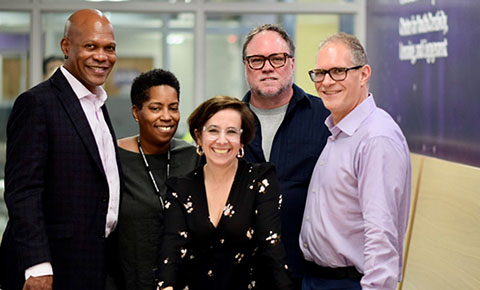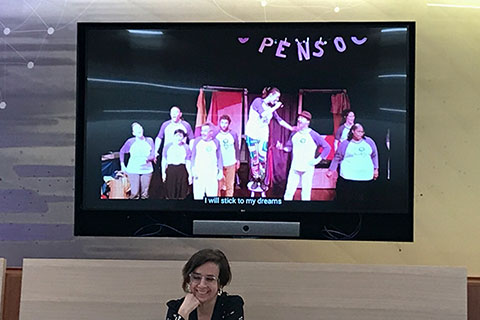Halverson: Using the Arts to Fix a Broken System

Northwestern University Alumna Erica Halverson’s new book “How the Arts Can Save Education” is, strangely enough, not about arts education. Instead, Halverson uses arts practices to fundamentally rethink how “learning” should be measured and to design learning environments and experiences that can serve all kids.
“In my world, we are not teaching and learning the arts,” Halverson said during a recent presentation at Northwestern’s School of Education and Social Policy. “The arts are teaching and learning.”
The distinction is an important one for Halverson (SoC97, PhD05), a double purple alumna who received her doctorate from SESP’s pioneering learning sciences program after earning a degree in theater from the School of Communication.
Now professor and department chair of Curriculum and Instruction at the University of Wisconsin–Madison, she is calling for a new era of education, one that rejects using test scores to measure success and one that meets children where they are.
“Instead of using education research ideas to explain the arts, I use the arts to explain how we ought to reimagine learning,” said Halverson, who studies how theater, music, visual arts, dance, and digital media tools can be used to reach students. “It may seem funny to say that learning needs to be reimagined. But most of the problems with education reform stem from the assumption that learning outcomes are fixed.”
During her talk, Halverson detailed Whoopensocker, a six-week program centered on creativity, expression, writing and collaborating that brings teaching artists into elementary schools.
 The children are introduced to improvisational games, a genre of performance across music, theater, and dance, where people spontaneously create their own material. Halverson calls improv “the backbone of teaching.”
The children are introduced to improvisational games, a genre of performance across music, theater, and dance, where people spontaneously create their own material. Halverson calls improv “the backbone of teaching.”
Her favorite improv rule– and the one that can best help transforming teaching practice– is “turn mistakes into opportunities.”
“Seeing mistakes as opportunities is a teaching strategy that values failure as an integral, necessary part of learning,” she said. “Unfortunately, in modern schooling discourse, we use failure to describe the state of not doing something or not learning. We apply the word to schools, to teachers, and of course, to students.
“By seeing mistakes as opportunities teachers and students can ask in the learning process, what happened here?” she added. “What did I mean to have happen? And how do these two things line up?”
Halverson offered three tips to help teachers quickly access arts practices and build connections between disciplines:
- Don’t be afraid to take risks: It’s a core feature of teaching and learning, she said. “Modeling how to take risks, and how to respond in ways that keep the flow of ideas going, is the first big idea of building the arts and everyday teaching.
- Embrace identity and representation, but do not mistake one for the other. “People use the arts to experiment with who they are and who they might become,” she said. “To test out new concepts and ideas, we need to allow these expressions to live in a playful space of experimentation. Be careful not to define makers by what they create.”
- Take collective responsibility. You don’t have to do this alone. “All artspace learning experiences are distributed across the learning ecology that includes formal and informal educators, young people, and a host of analog and virtual tools and resources,” she said.” Becoming a participant in this ongoing art making process allows you to take your part in keeping the conversation rolling.”
For Paul Goren, a former school superintendent and director of the Center for Education Efficacy, Excellence, and Equity at the School of Education and Social Policy, Halverson’s talk importantly addressed where learning occurs and how students can become even more engaged learners. “Her insights are extremely helpful for educators who are rethinking the planning and delivery of curriculum,” he said.
At Northwestern, Halverson co-directed Griffin’s Tale, a theater ensemble that creates a sketch comedy show from stories that have been sent in by schoolchildren. In 1997, she cofounded Barrel of Monkeys (now Playmakers Lab) to bring similar programming to underserved students in Chicago Public Schools.
Halverson’s Whoopensocker curriculum is based on her more than 20 years of research in arts education and the learning sciences showing that creative writing and performance programs can improve students’ literacy skills, help them develop their identity, and promote culturally sustaining practices.
“I can't promise you that embracing an arts-based vision for learning, teaching, and design will be easy,” she said. “But I do know that using the arts and art making will bring joy to classrooms and can lead the way toward a more equitable and just educational future for all.”
The event, held in SESP’s Center for Youth, Creativity, Learning, and Engagement (CYCLE) studio, was co-sponsored by Northwestern's School of Education and Social Policy and the School of Communication. Halverson was welcomed by SESP Dean David Figlio, School of Communication Dean E. Patrick Johnson, and several faculty members from the learning sciences program, including Mike Horn, Nichole Pinkard, Reed Stevens, and Uri Wilensky.
"It was so fitting to have Erica Halverson with us to help breathe life back into CYCLE after a long pandemic hibernation,” said Stevens, professor of learning sciences and CYCLE faculty member. “Because her work puts youth’s creativity center stage, literally. Her theater-based work shows so vividly how we as adults can co-create activity structures and environments with young people to advance their learning and celebrate their creativity.”